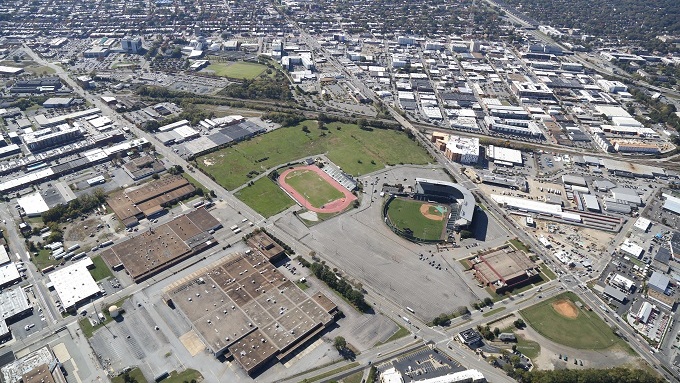
A southward view of the 67-acre Diamond District site, including The Diamond and nearby Sports Backers Stadium. (SkyShots Photography)
With initial land transfers completed and a newly acquired boost of local capital in the hands of its development team, the first phase of Richmond’s multibillion-dollar Diamond District project appears set to get into full swing.
RVA Diamond Partners, the team leading the massive mixed-use project, has secured millions of dollars in additional capital from multiple Richmond investors that it plans to put toward purchases of the land and initial bonds for the project’s first phase.
The recently secured funding was needed for the team to go forward with the phase, which includes a new stadium for the Richmond Flying Squirrels and initial commercial and residential development, tax revenue from which would be used to help fund the new ballpark.
Earlier this month, the city-owned land needed for the first leg was transferred to Richmond’s Economic Development Authority, which is slated to sell the parcels to RVA Diamond Partners after a number of closing conditions are met.
Those conditions include the minor-league ballclub signing a lease for the new stadium, and the creation of a community development authority (CDA), which would issue bonds to help finance the new stadium and infrastructure improvements for the larger development.
The zero-dollar transfer of the land was required for the EDA to petition City Council to create the CDA, a form of tax increment financing that governments can use to help finance a project using tax revenue generated by the development over time.
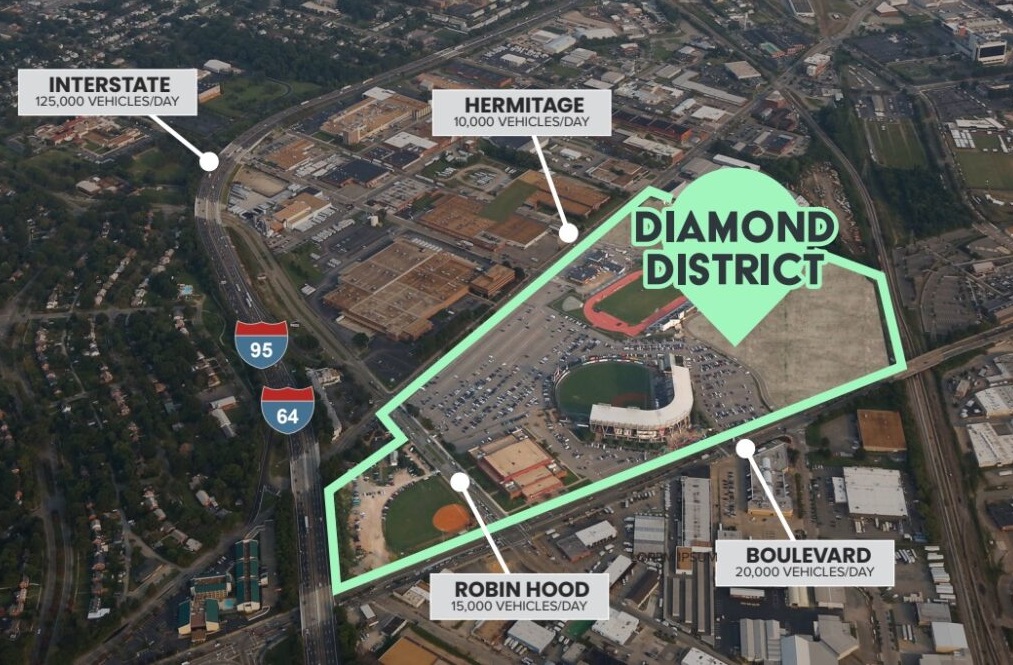
The 67-acre site is bordered by Arthur Ashe Boulevard, Hermitage Road, the interstate and the railroad tracks. (BizSense file)
The newly raised local capital will allow RVA Diamond Partners to purchase the nearly 22 acres that make up the first phase, as well as an initial series of the bonds for the ballpark and infrastructure.
According to the team’s development agreement with the city, RVA Diamond Partners is to pay $16 million for the land and purchase approximately $20 million in bonds.
With the needed capital secured, Jason Guillot, who heads up RVA Diamond Partners locally, said the team is ready to move forward.
“Our team has communicated to the city that we’re ready to go,” he said.
Guillot, a principal with local development firm Thalhimer Realty Partners, would not specify how much capital was raised or identify the investors that put up the funds, though he did say that all of them are local.
The funds add to other capital previously raised for the project by TRP and Loop Capital, a Chicago-based investment bank that’s also leading the team along with Republic Properties, a D.C.-based developer.
Loop Capital is underwriting the bonds for the ballpark. The firm, which has handled financing for other sports venue-anchored projects, also is involved in the redevelopment of the Oakland Coliseum site in California.
Double play
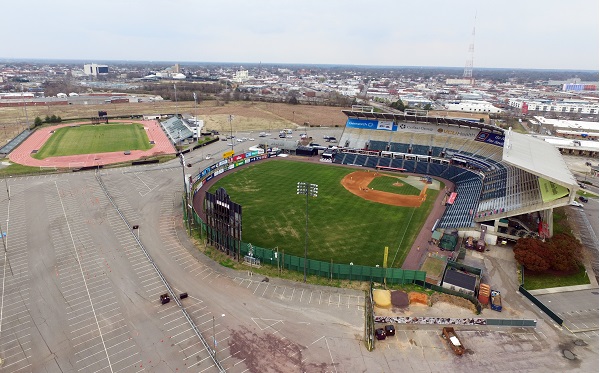
The area that makes up the Diamond District includes the namesake baseball stadium and nearby Sports Backers Stadium. (BizSense file)
The raised capital is welcome news for the city, which is aiming to complete the new stadium in time for the 2026 baseball season, to meet new facility standards set by Major League Baseball for pro baseball venues across the country.
MLB, which in recent years has assumed oversight of minor-league facilities like The Diamond, has set a 2025 deadline for compliance from all venues. While they’ve acknowledged that deadline won’t be met with the new ballpark, officials involved in the Diamond District have maintained that MLB is aware of the stadium that’s in the works with the project. The new Richmond ballpark is expected to take more than 18 months to build.
A change in approach to the new ballpark’s design and development was made in recent months, with that responsibility relinquished by RVA Diamond Partners and given to the Flying Squirrels via an arrangement with Machete Group, a Houston-based venue advisory and development management firm led by David Carlock.
Machete Group made its own pitch for the Diamond District RFP but lost out to RVA Diamond Partners. It then began advising the Squirrels as negotiations over the new stadium’s design were underway last year with DLR Group and JMI Sports – RVA Diamond Partners’ stadium designer and development consultant, respectively.
Machete Group is now more formally involved as the Squirrels’ stadium consultant, taking over for JMI. And stadium design work has shifted from DLR to Odell, an architecture firm with an office in Richmond that was the stadium designer on Machete’s Diamond District proposal.
The arrangement, which was described as mutually agreed-to, effectively frees up RVA Diamond Partners to focus on the rest of the $2.4 billion Diamond District development, with Machete and the Flying Squirrels taking the lead on the ballpark.
Guillot said the arrangement benefits the overall project.
Referring to the ballclub, he said, “The team felt that they would do a better job than us in leading design and construction, and get it done on time, so we all – the city and the Squirrels and MLB and us – decided that was best for the project.
“It’s more important to us that we have an agreement between the parties – that the team’s happy with the outcome, they control the design and the budget and the timeline. That’s how the project happens, because without the ballpark, the rest of the project doesn’t happen,” he said.
The new ballpark is being designed with a capacity of 9,400 and is projected to cost between $110 million and $120 million, up from an earlier estimate of $90 million. The projected cost does not include the cost of the land.
The stadium is to be financed with about $80 million in tax-exempt bonds, $20 million in subordinated debt, and at least $10 million in equity from the city, which would provide that using proceeds from the land sale to RVA Diamond Partners.
The rest of the first phase, including the commercial and residential development, would be financed through construction loans to be secured by the development team.
The new stadium would rise in the district’s southwest corner at Arthur Ashe Boulevard and the railroad tracks, with the rest of the first phase development rising around it. The Flying Squirrels would continue to play at The Diamond while the new ballpark is built.
Still in the game
Despite the changes in approach to the stadium specifically, Guillot said the rest of the development components of the overall Diamond District project have remained unchanged.
“All of the main pillars of the main project are still there,” Guillot said, referring to the city’s desired mix of office, residential and retail, a hotel to support those uses, and upgrades to infrastructure such as water, sewer and roads. The project also requires minority business participation and a mix of housing styles and price and rental ranges.
In addition to the ballpark, the first phase is to include more than 1,100 residential units, 20 percent of which would be lower-income homes; 58,000 square feet of retail; about 1,700 structured parking spaces; a 180-room hotel totaling about 109,000 square feet; and an 11-acre public park.
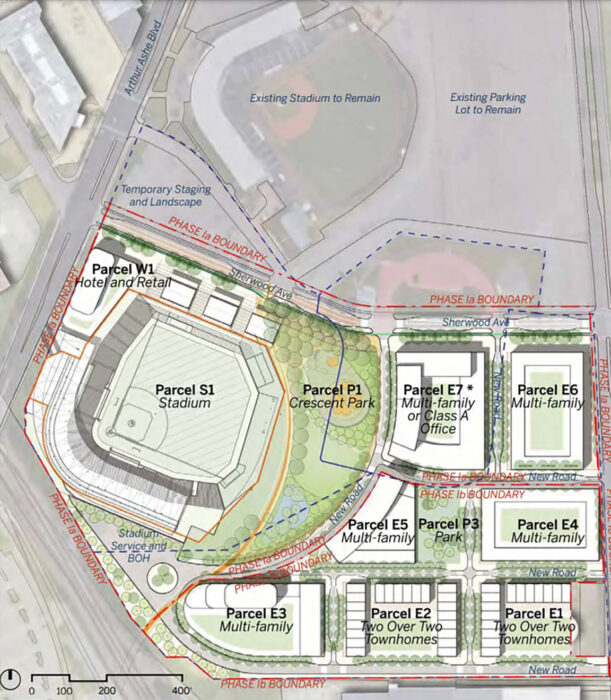
A conceptual site plan for the first phase of the project shows the new stadium in the Diamond District’s southwest corner.
Guillot said the first buildings to rise would include a 20,000-square-foot retail building flanking the new ballpark, and two apartment buildings, one of them market-rate and the other mixed-income with lower-income units.
He said construction on those buildings would start within a year of the CDA bonds closing, the land being sold to RVA Diamond Partners and the infrastructure put into place.
Minimum investment in the first phase has been projected at over $627 million. The larger Diamond District development is projected at $2.4 billion and targeted for completion in 15 years.
While the process to get to even the first phase of the project has taken time and presented challenges, Guillot said the development team has not wavered and is determined to see the Diamond District through.
“Our team has been committed to this project and transaction, and that’s why we’ve stuck with it this whole time,” he said. “We believe it’s too important to not happen – for the city as a whole, the neighborhood, the opportunity it brings, the affordable housing elements.
“There are so many aspects of this project that are transformative for Richmond, and that’s why, despite high interest rates and challenging capital markets, we’ve been committed to get the Diamond District project across the finish line, and that’s the truth,” he said. “It hasn’t been easy.”

A southward view of the 67-acre Diamond District site, including The Diamond and nearby Sports Backers Stadium. (SkyShots Photography)
With initial land transfers completed and a newly acquired boost of local capital in the hands of its development team, the first phase of Richmond’s multibillion-dollar Diamond District project appears set to get into full swing.
RVA Diamond Partners, the team leading the massive mixed-use project, has secured millions of dollars in additional capital from multiple Richmond investors that it plans to put toward purchases of the land and initial bonds for the project’s first phase.
The recently secured funding was needed for the team to go forward with the phase, which includes a new stadium for the Richmond Flying Squirrels and initial commercial and residential development, tax revenue from which would be used to help fund the new ballpark.
Earlier this month, the city-owned land needed for the first leg was transferred to Richmond’s Economic Development Authority, which is slated to sell the parcels to RVA Diamond Partners after a number of closing conditions are met.
Those conditions include the minor-league ballclub signing a lease for the new stadium, and the creation of a community development authority (CDA), which would issue bonds to help finance the new stadium and infrastructure improvements for the larger development.
The zero-dollar transfer of the land was required for the EDA to petition City Council to create the CDA, a form of tax increment financing that governments can use to help finance a project using tax revenue generated by the development over time.

The 67-acre site is bordered by Arthur Ashe Boulevard, Hermitage Road, the interstate and the railroad tracks. (BizSense file)
The newly raised local capital will allow RVA Diamond Partners to purchase the nearly 22 acres that make up the first phase, as well as an initial series of the bonds for the ballpark and infrastructure.
According to the team’s development agreement with the city, RVA Diamond Partners is to pay $16 million for the land and purchase approximately $20 million in bonds.
With the needed capital secured, Jason Guillot, who heads up RVA Diamond Partners locally, said the team is ready to move forward.
“Our team has communicated to the city that we’re ready to go,” he said.
Guillot, a principal with local development firm Thalhimer Realty Partners, would not specify how much capital was raised or identify the investors that put up the funds, though he did say that all of them are local.
The funds add to other capital previously raised for the project by TRP and Loop Capital, a Chicago-based investment bank that’s also leading the team along with Republic Properties, a D.C.-based developer.
Loop Capital is underwriting the bonds for the ballpark. The firm, which has handled financing for other sports venue-anchored projects, also is involved in the redevelopment of the Oakland Coliseum site in California.
Double play

The area that makes up the Diamond District includes the namesake baseball stadium and nearby Sports Backers Stadium. (BizSense file)
The raised capital is welcome news for the city, which is aiming to complete the new stadium in time for the 2026 baseball season, to meet new facility standards set by Major League Baseball for pro baseball venues across the country.
MLB, which in recent years has assumed oversight of minor-league facilities like The Diamond, has set a 2025 deadline for compliance from all venues. While they’ve acknowledged that deadline won’t be met with the new ballpark, officials involved in the Diamond District have maintained that MLB is aware of the stadium that’s in the works with the project. The new Richmond ballpark is expected to take more than 18 months to build.
A change in approach to the new ballpark’s design and development was made in recent months, with that responsibility relinquished by RVA Diamond Partners and given to the Flying Squirrels via an arrangement with Machete Group, a Houston-based venue advisory and development management firm led by David Carlock.
Machete Group made its own pitch for the Diamond District RFP but lost out to RVA Diamond Partners. It then began advising the Squirrels as negotiations over the new stadium’s design were underway last year with DLR Group and JMI Sports – RVA Diamond Partners’ stadium designer and development consultant, respectively.
Machete Group is now more formally involved as the Squirrels’ stadium consultant, taking over for JMI. And stadium design work has shifted from DLR to Odell, an architecture firm with an office in Richmond that was the stadium designer on Machete’s Diamond District proposal.
The arrangement, which was described as mutually agreed-to, effectively frees up RVA Diamond Partners to focus on the rest of the $2.4 billion Diamond District development, with Machete and the Flying Squirrels taking the lead on the ballpark.
Guillot said the arrangement benefits the overall project.
Referring to the ballclub, he said, “The team felt that they would do a better job than us in leading design and construction, and get it done on time, so we all – the city and the Squirrels and MLB and us – decided that was best for the project.
“It’s more important to us that we have an agreement between the parties – that the team’s happy with the outcome, they control the design and the budget and the timeline. That’s how the project happens, because without the ballpark, the rest of the project doesn’t happen,” he said.
The new ballpark is being designed with a capacity of 9,400 and is projected to cost between $110 million and $120 million, up from an earlier estimate of $90 million. The projected cost does not include the cost of the land.
The stadium is to be financed with about $80 million in tax-exempt bonds, $20 million in subordinated debt, and at least $10 million in equity from the city, which would provide that using proceeds from the land sale to RVA Diamond Partners.
The rest of the first phase, including the commercial and residential development, would be financed through construction loans to be secured by the development team.
The new stadium would rise in the district’s southwest corner at Arthur Ashe Boulevard and the railroad tracks, with the rest of the first phase development rising around it. The Flying Squirrels would continue to play at The Diamond while the new ballpark is built.
Still in the game
Despite the changes in approach to the stadium specifically, Guillot said the rest of the development components of the overall Diamond District project have remained unchanged.
“All of the main pillars of the main project are still there,” Guillot said, referring to the city’s desired mix of office, residential and retail, a hotel to support those uses, and upgrades to infrastructure such as water, sewer and roads. The project also requires minority business participation and a mix of housing styles and price and rental ranges.
In addition to the ballpark, the first phase is to include more than 1,100 residential units, 20 percent of which would be lower-income homes; 58,000 square feet of retail; about 1,700 structured parking spaces; a 180-room hotel totaling about 109,000 square feet; and an 11-acre public park.

A conceptual site plan for the first phase of the project shows the new stadium in the Diamond District’s southwest corner.
Guillot said the first buildings to rise would include a 20,000-square-foot retail building flanking the new ballpark, and two apartment buildings, one of them market-rate and the other mixed-income with lower-income units.
He said construction on those buildings would start within a year of the CDA bonds closing, the land being sold to RVA Diamond Partners and the infrastructure put into place.
Minimum investment in the first phase has been projected at over $627 million. The larger Diamond District development is projected at $2.4 billion and targeted for completion in 15 years.
While the process to get to even the first phase of the project has taken time and presented challenges, Guillot said the development team has not wavered and is determined to see the Diamond District through.
“Our team has been committed to this project and transaction, and that’s why we’ve stuck with it this whole time,” he said. “We believe it’s too important to not happen – for the city as a whole, the neighborhood, the opportunity it brings, the affordable housing elements.
“There are so many aspects of this project that are transformative for Richmond, and that’s why, despite high interest rates and challenging capital markets, we’ve been committed to get the Diamond District project across the finish line, and that’s the truth,” he said. “It hasn’t been easy.”

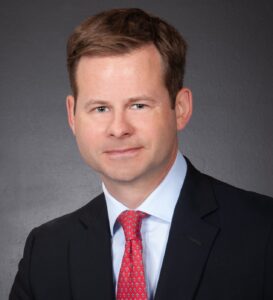


Let it roll!
congrats to Jason’s team
Good to see that this project is moving forward. The quicker the City can get this started, the quicker it can then focus on the City Center development, which could have a greater impact on the City’s skyline!
Here are some concerns regarding the new stadium, and the surrounding development: Why is a 9400-seat stadium needed, when the Flying Squirrels consistently average about 6200-6400 fans per game? There are many other Double A stadiums that are smaller, and the size of the stadium is directly related to the cost, currently estimated to be between $110-120 million! When will Sports Backers Stadium be purchased? It appears that the new stadium can’t be completed without it. I’m pretty sure that VCU is waiting for the sale to be finalized so that they can move forward with their sports complex along… Read more »
Love Brian’s questions and to add to them a bond company has already been selected for the stadium bonds even though the entity that will sell the bonds has not been created. So the to be created CDA, a political subdivision of the city and Commonwealth, is not going to follow public procurement laws?? Someone tell me how did an entity that does not even exist already have an underwriter for its bonds??
How many seats do you propose they have? Surely not 6,400, as that would eliminate those nights when they exceed the average. I decided to look at what I assume was more or less a typical series, a six-game series with Altoona in May. Average attendance was 6,867. On three nights, the crowds exceeded 8,000. Once, they had more than 9,000. Ninety-four hundred seems like a good number to me. I wouldn’t mind them going higher, but I know they want to keep the number manageable so as to have a somewhat intimate setting. The Diamond before used to have,… Read more »
I was hoping for 10,000 even just to be able to go back to triple a one day.
I think the attendance numbers have been similar between the AAA Braves and the AA Flying Squirrels.
Brian, you keep asking questions they’ve answered re: parking and traffic. The ballpark’s existing surface parking will remain during phase I of the development. As far as traffic goes why do you believe the existing infrastructure cannot handle event traffic? Arthur Ashe Boulevard and Hermitage Rd already handle thousands of vehicles a day and existing game day traffic won’t be any different. When a stadium /arena is built it’s understood people may have to walk and park more than a couple of blocks from the venue. The bigger question is if the venue has a dedicated transit plan and if… Read more »
When the Diamond was built the metro Richmond population was 500K less than currently and at times sold out the 12,000 capacity. There are plenty of sell outs now, I don’t think they will have any trouble filling 9-10K per game in a new stadium that is a much better fan experience. I think they could sell 3X the suites and corporate ticket bundles easily with a new facility. Keep in mind the Diamond is easily one of the worst minor league stadiums. I don’t know the total number of new buildings and number of units coming online in Scotts… Read more »
Truth. I attend several games per year and have played music on the concourse. The fan experience is awful. Kudos to the Squirrels and Parney for keeping things lively, but it’s a pain to go to the restroom. If you’re in a wheelchair, it’s virtually inaccessible. The food concessions are poor, and the service is horrible. Even improving those three things – access, food, infrastructure – would vastly improve the experience and boost attendance.